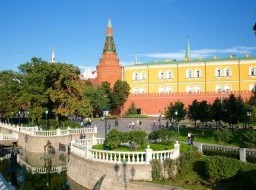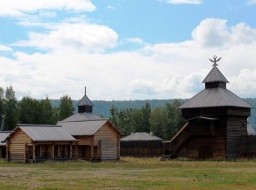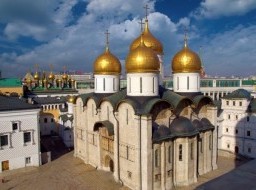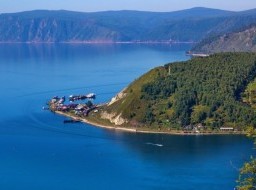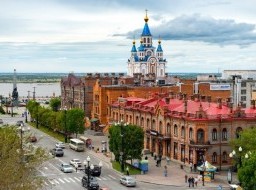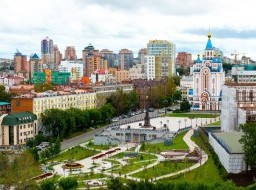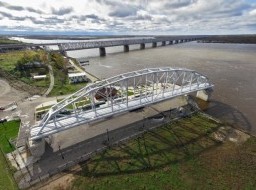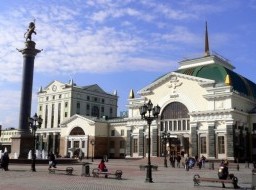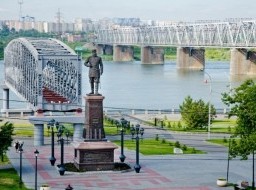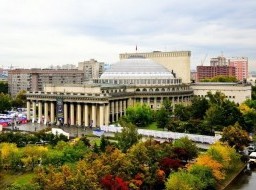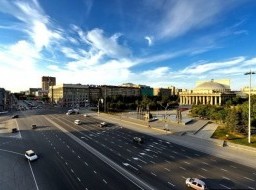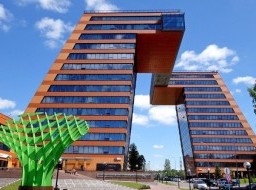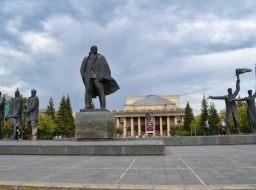Khabarovsk
Khabarovsk is the fabulous capital of the Russian Far East, that deserves to be named the most beautiful city of the Far East of Russia with its rich historic and cultural heritage. Located high on the bank of the Amur River, Khabarovsk is one of the oldest cities in the Amur region and one of the largest cities in the Russian Far East with a population of 650 000. It was founded and developed according to ancient urban construction rules: located on a high river bank, facing a wide and spacious river, built for a population consisting of military, crafts and trade people. Its position attracted everyone who ever lived on the Amur river or floated over it. Khabarovsk displays a remarkable richness of architecture that includes elegantly restored 19th century buildings, historic monuments, sanctuaries and museums. This provincial city on the banks of the Amur River has a relaxed, "seaside resort" atmosphere, and a surprisingly European feel for a city only 25km from China. The expansive, pristine forests of the Khabarovsk region are an ecological crossroads where one can find temperate species such as Siberian tiger, Himalayan bear, and giant Blakiston's fish owl, along with northern Arctic species like moose and the Steller's sea eagle. Khabarovsk was founded in 1858 as a military post by eastern Siberia's governor general, Count Nikolai Muravyov, during his campaign to take the Amur back from the Manchus. The city was originally named Khabarovka in honor of a Vologda peasant and later a Siberian dealer Jerofei Khabarov - one of the first in the exploration and settlement of Siberia of the 17th century. On April 28, 1880 Khabarovka received the status of city, and in 1884 it officially became the capital of the Priamurskoye General-Governorship. However, only in 1893 the city was given its current name of Khabarovsk. The city stands in Sredneamursky lowland, just 30 km away from the border with China. Its population is about 615 thousand persons. Khabarovsk is famous for its fur craft. Its numerous beautiful parks, riverside paths and historic downtown area make Khabarovsk a favorite place with visitors to the region. Russian masterpieces, early Slavic icons and a collection of Western European art can be enjoyed in the beautifully restored Fine Arts Museum overlooking the Amur River. It is within 30km of the Chinese border, but still retains a strong European feel and influence, most notably in the form of distinctive 19th century brick buildings and broad tree-lined main streets. The city planning is quite simple but very attractive. There are three major streets: Seryshev, Muraviev-Amursky and Lenin. Muravyov-Amursky Street, the main and most beautiful street of the city, with a number of shops, administrative buildings, cinemas, and theaters (The Drama Theater, The Youth Theater). With promotion of the Governorship’s rank and construction of the Trans-Siberian Railway, the city started to grow rapidly, attracting more and more settlers. In 1924 Khabarovsk became the center of the Far Eastern Krai (Region), the successor of the Priamurskoye General-Governorship and the Far Eastern Republic, and in 1938 - the center of the Khabarovsky region. Today Khabarovsk is one of the major cities of the Russian Far East. It is also an acknowledged center of science, culture and international tourism in the Russian Far East. The location of the city as a gateway of overland, water and air ways connecting the landlocked regions of Russia with the countries of the Pacific Ocean basin makes it a powerful transportation junction for the Far East. There are several professional theaters, including Drama Theater, Musical Comedy Theater, Young Spectators' Theater, Triada Theater (Pantomime), White Theater, Puppet Theater and Circus. Very popular with the public is the Far Eastern Symphony Orchestra; there is a Concert Hall in the Philharmonic Society. The magnificent three-kilometer-long bridge over Amur River built in 1916 still remains the symbol of Khabarovsk. The very first monument in Khabarovsk was a monument to Count Nikolay Muravyov-Amursky set up in 1891. It was taken down in 1925, and then restored exactly in 1992. By the way, the city has an entire avenue of park sculptures of the 1940s-1950s. The St. Bishop Innocent of Irkutsk Church founded in 1870 is the main orthodox church of the city. It was constructed on the place of a wooden church. During the Soviet period it was used as a planetarium. The Holy Transfiguration Cathedral is considered the third largest of all orthodox churches of Russia, after Christ the Savior Cathedral in Moscow and St. Isaac Cathedral in St. Petersburg. Khabarovsk offers one of the largest remaining expanses of unfragmented temperate rainforest in the North Pacific. The rivers of the Khabarovsk region flow from the headwaters of the Amur east into the Sea of Okhotsk and host a rich assemblage of salmon, char and taimen species. The Amur tigers are the biggest cats on the Earth and can be almost exclusively in Russia, Primorsky and Khabarovsk regions. This gorgeous wild cat is protected by state and listed in the Red Book of Russia. The Amur tiger is a jewel of the Far Eastern taiga and the pride of the Russians, besides the Siberian tiger is one of the symbols of the Primorsky Territory. Beautiful, strong animals are living in the north-eastern region. Usually these animals can be observed only in the cells of zoos, but here they feel at ease on a fairly large enclosure of the forest area. |



